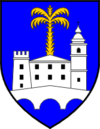Crikvenica
| Crikvenica | ||
|
||
|
|
||
| Basic data | ||
|---|---|---|
| State : |
|
|
| County : |
|
|
| Height : | 0 m. i. J. | |
| Residents : | 11,122 (2011) | |
| Telephone code : | (+385) 051 | |
| Postal code : | 51 260 | |
| License plate : | RI | |
| Boat registration : | CK | |
| Structure and administration (status: 2013, cf. ) |
||
| Community type : | city | |
| Mayor : | Damir Rukavina ( HDZ ) | |
| Postal address : | Ulica kralja Tomislava 85 51 260 Crikvenica |
|
| Website : | ||
Crikvenica (literally little church , German outdated Cirknenz , Italian Cirquenizza ) is a town on the Croatian Adriatic coast, about 37 km from Rijeka and one of the major tourist centers in the region. According to the 2011 census, the population of Crikvenica is 11,122. Neighboring towns of Crikvenica are Kraljevica , Novi Vinodolski and Selce .
Crikvenica has a sandy beach ( Croatian Crni Mol ), which was created by sand alluvium.
history
The region is first mentioned in the Tabula Peutingeriana , a 13th century reconstruction of a Roman map from the 3rd century. There the station Ad Turres is mentioned, marked on the main road between Aquileia and Salona , at the exact place where Crikvenica is today. Recent excavations show that this settlement was one of the larger settlement centers in the region in the 1st century BC. During excavations, archaeologists found one of the largest ceramic manufacturers of that time here. The remains of amphorae found indicate a style of their own for the amphorae made here , which has not been found anywhere else.
Remains of Roman villas have also been found in the districts of Dramalj and Jadranovo. Dramalj is also known for paleontological finds in Vrtare Male Cave. Well-preserved skeletons of elephants, cave lions, rhinos and several other now extinct species have been discovered there. These skeletons are approximately 30,000 years old.
The city got its name after the church ( Croatian crkva ) of the Pauline monastery, which was built in 1412. This church was donated to the Paulins by Prince Nikola Frankopan IV . The corresponding deed of donation is the first document in which Crikvenica was mentioned by name. In the same place, at the mouth of the Dubracina River, there is now the Church of the Assumption of the Blessed Virgin Mary.
From 1749, the Croatian coastal area surrounding the city of Crikvenica was referred to as the Austrian coastal area. After the Austro-Hungarian settlement in 1867, however, the area became officially Croatian coastal country again . It remained Austrian or Hungarian until the end of the Austro-Hungarian monarchy.
In 1891 the first hotel was opened in Crikvenica. A decade later, Crikvenica was officially declared a climatic health resort and developed into a preferred travel destination, especially for the Hungarian nobility during the time of the Danube Monarchy .
Town twinning
The city maintains city partnerships or friendships with the following cities:
|
Personalities
Crikvenica is the birthplace of the violinist, conductor and music teacher Ljerko Spiller (1908–2008).
photos
Web links
- City website (Croatian)
Individual evidence
- ↑ http://www.kvarnerpalace.info/de/enthaben/es-war-einmal/
- ↑ The city's website - gradovi prijatelji , accessed on March 22, 2018





